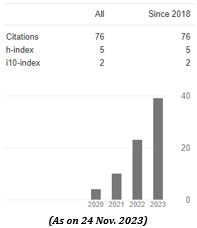STRUCTURAL CHARACTERIZATION OF LEGIONELLOSIS DRUG TARGET CANDIDATE ENZYME PHOSPHOMANNOMUTASE FROM LEGIONELLA PNEUMOPHILA STRAIN PARIS: AN IN SILICO APPROACH
Abstract
The harshness of legionellosis differs from mild Pontiac fever to potentially fatal Legionnaire’s disease. The
increasingdevelopment of drug resistance against legionellosis has led to explore new novel drug targets. It has
been found thatphosphoglucosamine mutase, phosphomannomutase, and phosphoglyceromutase enzymes can
be used as the mostprobable therapeutic drug targets through extensive data mining. Phosphomannomutase
isconcerned in a process called glycosylation.The purpose of this study was to predict the potential target of
that specific drug. For this,the 3D structure of Phosphomannomutase of Legionella pneumophila (strain Paris)
was determined by means ofhomology modeling through Phyre2 and refined by ModRefiner. The designed
model was evaluated with a structurevalidation program, for instance, PROCHECK, Verify3D, and QMEAN,
for further structural analysis. Secondary structural features were determined through self-optimized prediction
method with alignment (SOPMA) and interacting networks by STRING. The analytical result of PROCHECK
showedthat 91.0% of the residues are in the most favored region, 8.50% are in the additional allowed region
of the Ramachandran plot. Verify3D graph value indicates a score of 0.77 and 0.91 for QMEAN respectively.
The findings of this current study along with further extensive investigation may assist drug design against
Legionellosis.
Downloads
References
Schousboe, A. Widmer, J. Summersgill, T. File, C. M.
Heath, D. L. Paterson, and A. Chereshsky, Distribution
of Legionella species and serogroups isolated by culture in
patients with sporadic community-acquired legionellosis:
an international collaborative survey, J InfectDis, 186,
(2002), 127-128.
[2] R. M. Atlas, Legionella: from environmental habitats
to disease pathology, detection and control, Environ
Microbiol, 1, (1999), 283-293.
[3] N. K. Fry, S. Alexiou-Daniel, J. M. Bangsborg, S.
Bernander, M. CastellaniPastoris, J. Etienne, B. Forsblom,
V. Gaia, J. H. Helbig, D. Lindsay, P. C. Lück, C. Pelaz, S.
A. Uldum, and T. G. Harrison, A Multicenter evaluation
of genotypic methods for the epidemiologic typing of
Legionella pneumophilaserogroup 1: results of a pan-
European study, ClinMicrobiol Infect, 5, (1999), 462-477
[4] P. C. Lück, J. H. Helbig, V. Günter, M. Assman, R.
Blau, H. Koch, and M. Klepp, Epidemiologic investigation
by macrorestriction analysis and by using monoclonal
antibodies of nosocomial pneumonia caused by Legionella
pneumophilasero group 10, J ClinMicrobiol, 32, (1994),
2692-2697.
[5] J. M. Pruckler, L. A. Mermel, R. F. Benson, C.
Giorgio, P. K. Cassiday, R. F. Breiman, C. G. Whitney,
and B. S. Fields, Comparison of Legionella pneumophila
isolates by arbitrarily primed PCR and pulsed-field Gel
electrophoresis: analysis from seven epidemic investigations,
J ClinMicrobiol, 33, (1995), 2872-2875.
[6] D. Schoonmaker, T. Heimberger, and G. Birkhead,
Comparison of ribotyping and restriction enzyme analysis
using pulsed-field gel electrophoresis for distinguishing
Legionella pneumophila isolates obtained during a
nosocomial outbreak, J ClinMicrobiol, 30, (1992), 1491-1498.
[7] M. J. Struelens, Consensus guidelines for appropriate
use and evaluation of microbial epidemiologic typing
systems, ClinMicrobiol Infect, 2, (1996), 2-11.
[8] C. Lawrence, M. Reyrolle, S. Dubrou, F. Forey, B.
Decludt, C. Goulvestre, P. Matsiota-Bernard, J. Etienne,
and C. Nauciel, 1999. Single clonal origin of a high
proportion of Legionella pneumophila serogroup 1 isolates
from patients and the environment in the area of Paris,
France, over a 10-year period, J ClinMicrobiol, 37, (1999),
2652-2655.
[9] L. A. Kelley, S.Mezulis, C. M. Yates, M. N.Wass and
M. J. E. Sternberg, The Phyre2 web portal for protein
modeling, prediction and analysis, Nature Protocols, 10,
(2015), 845–858.
[10] L. Jolly, F. Pompeo, J. van Heijenoort, F. Fassy,
D. Mengin-Lecreulx, Autophosphorylation of
phosphoglucosaminemutase from Escherichia coli, J
Bacteriol, 182, (2000), 1280-5.
[11] S. Grünewald, The clinical spectrum of
phosphomannomutase 2 deficiency (CDG-Ia),
BiochimBiophysActa, 1792, (2009), 827-34.
[12] M. Magrane, and UniProt Consortium, UniProt
Knowledgebase: a hub of integrated protein data,
Database,2011, (2011), bar009.
[13] C. Geourjon, and G. Deléage, SOPMA: significant
improvements in protein secondary structure prediction
by consensus prediction from multiple alignments,
ComputApplBiosci, 11, (1995), 681–4.
[14] A. Franceschini, D. Szklarczyk, S. Frankild, M.
Kuhn, M. Simonovic, A. Roth, STRING v9. 1: proteinprotein
interaction networks, with increased cover-age and
integration,Nucleic Acids Res, 41,(2013), D808–15.
[15] O. Trott, and A. J. Olson, AutoDock Vina: improving
the speed and accuracy of docking with a new scoring
function, efficient optimization and multithreading,
Journal of Computational Chemistry, 31, (2010), 455-461.
[16] P. Palaga, L. Nguyen, U. Leser, J. Hakenberg, Highperformance
information extraction with Alibaba, EDBT
ACM, 360, (2009), 1140-1143.
[17] S. Fidanova, and I. Lirkov, 3D Protein Structure
Prediction, JAnaleleUniversitatii de Vest Timisoara Seria
Matematica Informatica, 2, (2009), 33-46.
[18] L. A. Kelley, and M. J. Sternberg. Protein structure
prediction on the Web: a case study using the Phyre server,
NatProtoc, 4,(2009), 363-71.
[19] C. Colovos, and T. O. Yeates, Verification of protein
structures: patterns of nonbonded atomic interactions,
ProteinSci, 2, (1993), 1511-9.
[20] D. Premalatha, P. Ravindra, L. V. Rao, Homology
modeling of putative thioredoxin from Helicobacerr pylori,
Indian J Biotechnol, 6, (2007), 4859.
[21] J. U. Bowie, R. Lüthy, D. Eisenberg, A method to
identify protein sequences that fold into a known threedimensional
structure, Science, 253, (1991), 164-70.
[22] P. Benkert, M. Künzli, T. Schwede, QMEAN server
for protein model qualityestimation, Nucleic Acids Res, 37,
(2009); 10-4.
[23] D. T. Jones, Protein secondary structure prediction
based on position-specific scoring matrices, J MolBiol,292,
(1999), 195-202.
[24] P. Benkert, M. Biasini, T. Schwede, Toward the
estimation of the absolute quality of individual protein
structure models, Bioinformatics,27, (2011), 343- 50.
[25] P. Benkert, T. C. Tosatto, D. Schomburg, QMEAN:
A comprehensive scoring function for model quality
assessment, Proteins, 71, (2008), 261-77.
Though MIJST follows the open access policy, the journal holds the copyright of each published items.

This work is licensed under a Creative Commons Attribution-NonCommercial 4.0 International License.
















